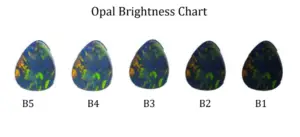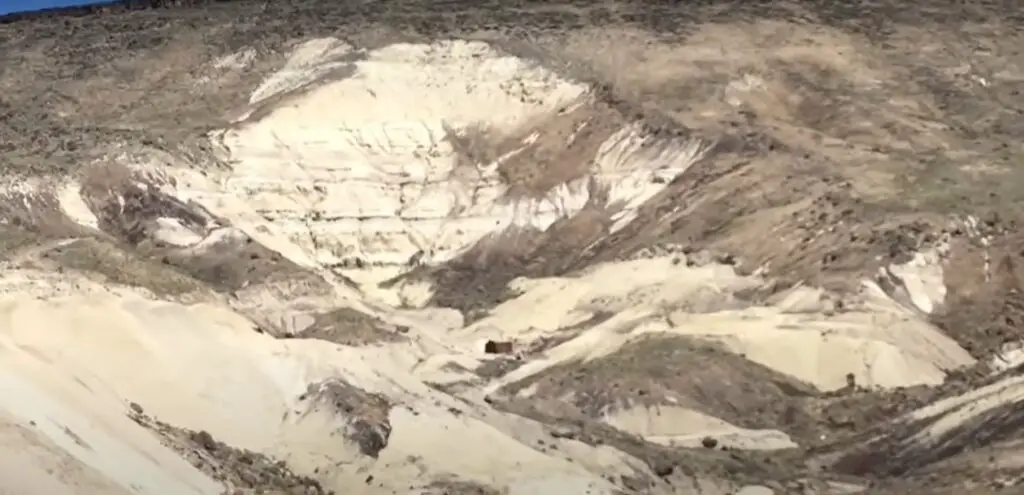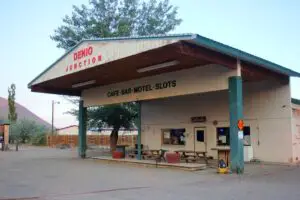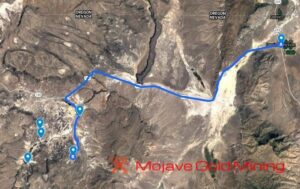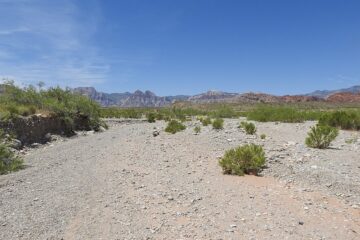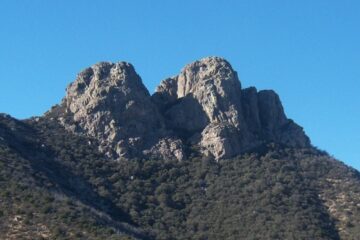Where is black opal found
Black opal is found in only three places in the world. Close to the Oregon border in the remote Virgin Valley area of far northwestern Nevada, a relatively recent find in Ethiopia, and the famous deposits of Lightning Ridge in Australia.

Bank mining area at a Virgin Valley opal mine
What is black opal
There are several types of precious opal. White, black, boulder, and crystal, among others. Black opal contains trace amounts of iron oxides, manganese oxide and carbon which darken the stone causing the flashes of color to be much more vivid than in the lighter colored opals.
How much is black opal worth
Black opal is the most prized of all the opals. Finished stones can sell for several hundred to several thousand dollars per carat. The finest of finished black opal stones can sell for upwards of $15,000 a carat. There have been black opals found at the Virgin Valley opal mines that have been valued at over $50,000 in their rough form.
It all depends on the darkness of the background and the brightness and pattern of the color play, known as opalescence. Black opal is graded from N1 to N4, with N1 being the darkest background, known as the body tone scale. The brightness scale of the color play is graded from B1 to B5, with B5 being the brightest.
Color play patterns also affect value with color on color being very valuable, as are flagstone patterns, and what is known as Chinese writing.
Where to dig for black opal
There are several opal dig sites in Nevada’s Virgin Valley that are open to the public. These sites are commercial mines that charge a fee to collect opal. The rates are not cheap, but some of the opals that can be found are of very high quality.
One high-quality black opal could easily pay for your trip, even in its rough form. It’s not uncommon to collect several specimen-grade precious black opals from a trip to one of the Virgin Valley opal mines.
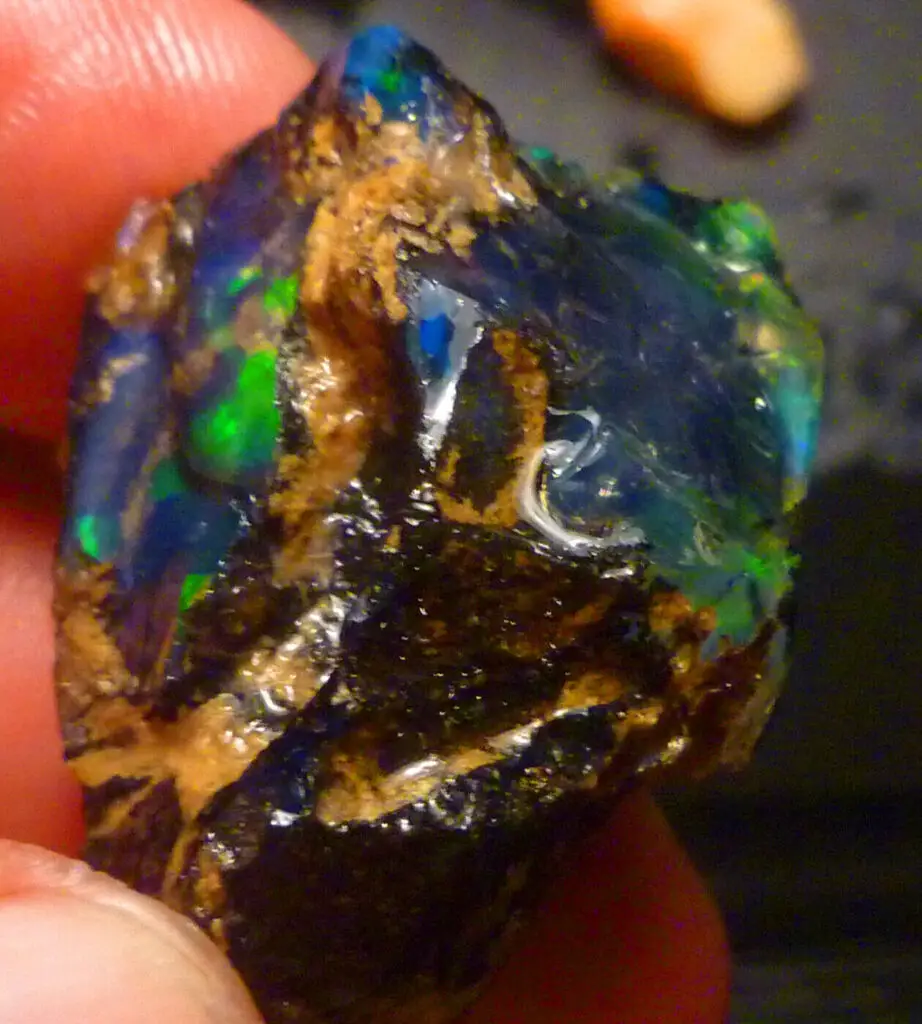
Black opalized wood from the Virgin Valley, Nevada
As with any collecting area, finding opals can be hit or miss, but that is half the fun, you never know what treasures you may uncover. Some visitors go home with several thousand dollars worth of beautiful black opals.
Virgin Valley, Nevada black opal
Black opal from the Virgin Valley is quite prevalent. All opal is unstable, some more than others. Most of the black opal from the Virgin Valley is unstable. Approximately 90 percent is specimen grade that should be kept in water.
The opals can have many small fractures and cracks called crazing. This crazing can worsen from continued exposure to light and oxygen. It is possible for opals to lose some or all of their color over time and even crumble to pieces from this phenomenon. Opal is a hydrated silica gel and Virgin Valley opals have an especially high water content.
That being said, some of the Virgin Valley black opal is truly world-class and among the most beautiful there is.
Tips for finding Black opal
Opals from the Virgin Valley are found as chips and nodules around and below volcanic ash beds They are often found associated with petrified conk wood which are known as limb casts. This opalized wood is usually the most stable of the Nevada opals.
Always be on the lookout for the shapes of twigs and small branches as oftentimes the opals are coated with a mix of sand and bentonite clays and the shape may be your only clue. After you uncover an opal it should be immediately placed in water to prevent cracking.
There are generally two types of opal mining at the Virgin Valley dig sites. The first is bank mining into the side of the virgin deposits. The second is combing through the tailings left over from the bank miners.
The tailings are moved to a separate area where you can rake and screen through the material. Tailings mining is less expensive than bank mining and the opals will usually be smaller and widely scattered through the material. They say that the bank miners miss about 35% of the opals.
The benefit of tailings mining is that the opals have been able to cure in the elements for a while and will generally be more stable, possibly stable enough for jewelry applications.
Bank mining is pick and shovel work. Look for voids and openings in the banks. Also look for fine sprays of selenite crystals as they can indicate nearby opal. There are other types and colors of opal in the Virgin Valley. About 80% of which has no fire or color play and is known as common opal or potch.
Nevada opal mines
Rainbow ridge opal mine
The Rainbow Ridge opal mine has been active since 1907 and has been owned and operated by the same family since 1949. There have been many world-class black opals found here over the years. Rainbow Ridge is where the famous 2,585 carat Roebling black opal was discovered in 1917 and was later donated to the Smithsonian Institute, where it resides today.
As I write this, the fees for bank mining at the Rainbow ridge mine are $700 (two adults) for virgin ground mining and $100 (per adult) for tailings mining per day, reservations required. Season is from mid May to mid September, 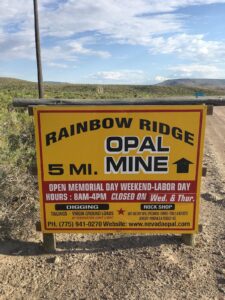 weather permitting. No camping allowed although there are campgrounds in the Virgin Valley. Here is a link to their website.
weather permitting. No camping allowed although there are campgrounds in the Virgin Valley. Here is a link to their website.
Instead of going to the wall to bank mine Rainbow Ridge will bring a loader scoop of virgin ground to you. This scoop will easily keep two adults busy all day searching for opal. Tools and water are available here. The folks at Rainbow ridge want you to find opal and will give you advice and tips to help in your search. They have a shop with lots of accessories and water dome display cases for your opal rough.
Royal Peacock opal mine
The Royal Peacock opal mine has been owned and operated by the same family since 1944 and open to the public since 1981. Because of the high quality of these opals, the Royal Peacock mine was the reason behind the naming of  Virgin Valley black opal as one of Nevada’s official state gemstones, the other being turquoise.
Virgin Valley black opal as one of Nevada’s official state gemstones, the other being turquoise.
The Royal Peacock has quite a few services in place including an RV park, dry-camping areas, showers and restrooms. They have an opal shop and offer limited tool rentals as well.
Mining season is from mid May to mid September. As I write this the dig fees are $190 per person for bank mining and $75 each for tailings mining. Children under 12 can mine for free but they are only allowed in the tailings areas. Helpful staff onsite will give mining advice and answer your questions. Some amazing black opals can be found here. Here is a link to their website for more information. Happy hunting!
Bonanza opal mine
The Bonanza opal mine is open to the public for tailings mining at $70 per day per person. Kids under 12 mine for free.
Bank mining and camping is only for the mine shareholders. Purchasing a share in the Bonanza gives you a 1% ownership in the mine. Contact the Bonanza mine here and they can give you more information. I’ve heard the tailings mining at the Bonanza mine can be very good too.
Open season is mid May to mid September weather permitting. Reservations not required. You might want to call ahead as most of the area mines are closed for two days midweek. The Bonanza mine is known for some of the brightest opals in the Virgin Valley. Some amazing black opal is found here.
Kokopelli opal mine
The Kokopelli opal mine is the new kid on the block in the Virgin Valley. A bit harder to get to, and a bit more remote, there is a lot of area to search here.
For a single fee you can bank mine, tailings mine and even hike to several virgin ground areas.
Children 12 and under free, Adults $180 each. Teens, seniors and military receive a reduced rate.
Season from mid May to mid October, reservations required. If you want to explore some untouched areas this might be the spot for you. Check out their website here for more. Black opal, limb casts and even fossils can be found here.
Come prepared
The Virgin Valley is a beautiful, rugged and remote area of the northern Great Basin. High plains country with an average elevation around 6000 feet. Be prepared for large variations in temperature, hot days and cold nights.
Bring plenty of sunscreen. a good hat and I recommend a good pair of boots. MSHA may even require hard hats and steel toe boots in the bank digging aeas now. make sure to contact the mine before you leave.
I would recommend taking some basic tools too. A small pick/mattock like this one works well in the banks and is less likely to ruin opal specimens than a large one.
A mason’s hammer similar to this one will help break up the hardened clay too.
Take spray bottles and water to wet your opals as you remove them from the banks. A watertight plastic Tupperware style container should be used to keep your opals in water as you work. Also useful are large flathead screwdrivers to help free the opals from the clays.
Removing opals from the ground is delicate work. When you uncover a bit of glass, take your time and work carefully to avoid breaking. Some miners use a wood framed screen to help sort the material, especially in the tailings areas.
Gas, food and lodging
The Virgin Valley is located in Humboldt County, Nevada about 35 miles southwest of the tiny town of Denio Junction (gas and diesel) . About a 10 hour drive from Los Angeles.
Fill up on Gas and supplies in Winnemucca which is about 140 miles south of the Virgin Valley, or Lakeview, Oregon about 100 miles west.
The Virgin Valley lies within the Sheldon National Wildlife Refuge which has several designated campgrounds, closest to the opal mines is the Virgin Valley Campground which has water, pit toilets, a shower house and a hot spring fed swimming hole. A good place to bring your RV for a boondocking base camp. There are other recreation opportunities in the wildlife refuge including fishing, hunting and wildlife photography.

